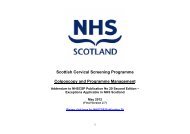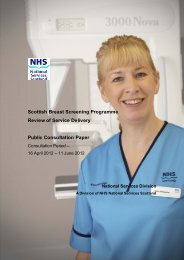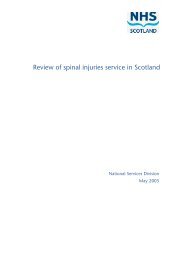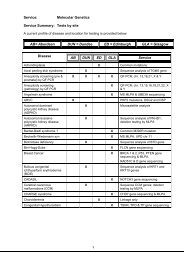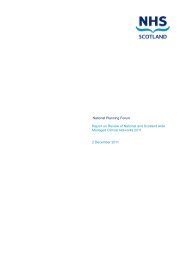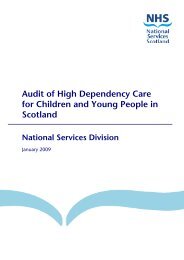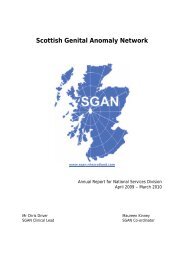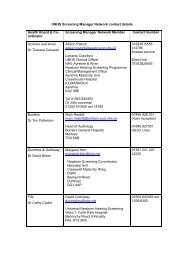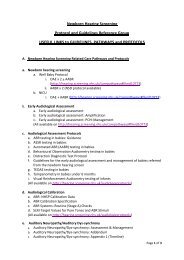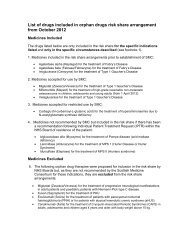Spinal Injuries Unit Annual Report Appendix 3 - National Services ...
Spinal Injuries Unit Annual Report Appendix 3 - National Services ...
Spinal Injuries Unit Annual Report Appendix 3 - National Services ...
Create successful ePaper yourself
Turn your PDF publications into a flip-book with our unique Google optimized e-Paper software.
Queen Elizabeth <strong>National</strong><strong>Spinal</strong> <strong>Injuries</strong> <strong>Unit</strong> forScotland<strong>Appendix</strong> ThreeDepartmental <strong>Report</strong>s3.1 Physiotherapy3.2 Occupational Therapy3.3 Psychology3.4 Momentum3.5 <strong>Spinal</strong> Injury Scotland3.6 SPIN3.7 Social WorkQueen Elizabeth <strong>National</strong> <strong>Spinal</strong> <strong>Injuries</strong> <strong>Unit</strong>Acute <strong>Services</strong> DivisionNHS Greater Glasgow and Clyde1345 Govan Road, Glasgow, G51 4TFTel: 0141 201 2555Fax: 0141 201 2778 E-mail: spinalunit@ggc.scot.nhs.uk
Service Access.Weekday Service Hours: 8.30am- 4.30 Mon to Fri.Weekend Service Hours: One of the SIU physiotherapists covers any work that is neededat the weekends. Once this work is completed they leave the hospital and the emergencycall-out system is reverted to.Emergency cover:Mon-Fri 4.30pm-8.30am via the hospital wide on-call physiotherapy service. Weekendsonce the SIU physiotherapist has left the hospital, usually from midday onwards until 8.30the following morning.Service Activity.Breakdown of patient groups treated.New admissions 06/07. 07/08. 08/09. 09/10.Neurological Deficit Total (%) Total (%) Total (%) Total (%)Incomplete Quadraplegia 31(43%) 37(44%) 49(54%) 43(43%)Incomplete Paraplegia 4(5%) 17(20%) 7(8%) 18(18%)Cauda Equina lesions 14(19%) 14(16%) 10(11%) 10 (10%)Complete Quadraplegia 6(8%) 6 (7%) 12(13%) 13 (13%)Complete Paraplegia 10(14%) 11(13%) 12(13%) 14(14%)Monoplegia 6(8%) 0 1( 1%) 0(0%)Incomplete Others 2(3%) 0 0 1(1%)Neuro deficits Total: 73(100%) 85(100%) 91(100%) 99(100%)Intact. 67 81 69 52Total: 140 166 160 151Readmissions. 16 28 20 14Every one of these patients was seen by the physiotherapy department, the incompletetetraplegic patients taking the most time, through to the intact patients, who are seen asappropriate, but are usually only on the unit for approximately two weeks.Re-admitted patients.All patients who are readmitted receive physiotherapy input if appropriate. This would be anumber of times per day, in the case of a chest infection, to twice per week to maintain therange of movement in paralysed joints while the patient is on bed rest to heal a pressure sore.Inpatient attendance's and direct patient contact treatment units:2009/10 In-Patients Out-patientsMonth Totals N.P Attendances <strong>Unit</strong>s Totals N.P Attendances <strong>Unit</strong>sApril 50 16 946 1999 0 0 0 0May 54 15 849 1930 2 2 2 9June 53 14 824 1824 3 1 3 8July 63 13 1092 2141 1 1 2 2August 51 12 1001 2057 6 6 12 342
Out Patients.There are four types of out patient seen by the physiotherapy department. Firstly thosepatients continuing their rehabilitation having had an early discharge, secondly those patientsreturning for further rehabilitation having made some form of recovery, or deterioration. Thirdlypatients requiring pain management, predominantly with acupuncture, and finally, thosepatients requiring a one off assessment.Outpatients:The figure's were as follows:Year: 06/07. 07/08. 08/09. 09/10.Attendance 81 68 30 58Direct units 127 192 92 139New patients 39 42 28 26We remain understaffed to treat outpatients as thoroughly as we would like to.On call after 5pm.This service is provided by the on call physiotherapists for the whole of the Southern GeneralHospital, and is provided as pre arranged treatments for patients with chest complaints that willdeteriorate if not treated at night and emergency call outs from a Registrar or Consultant.During the past 3 years the figures were:Year: 07/08. 08/09. 09/10.Attendance 68 28. 39Direct units 194 85. 118Total hours 48.5hrs 21.25hrs. 29.5hrsDEPARTMENT ARRANGED CALL-OUTTOTALSPINAL 22009/10 Pt's attendances units TOTAL Pt's attendances unitsAPRIL 4 4 11 2 2 7MAY 1 1 3 2 2 9JUNE 0 0 0 0 0 0JULY 0 0 0 0 0 0AUGUST 0 0 0 0 0 0SEPT 5 6 17 2 2 6OCT 0 0 0 1 1 4NOV 0 0 0 0 0 0DEC 1 2 5 0 0 0JAN 1 1 2 1 1 4FEB 7 10 28 0 0 0MARCH 3 3 7 4 4 15TOTALS 22 27 73 12 12 454
Education/ Training.For most physiotherapists learning about and gaining experience in <strong>Spinal</strong> Cord Injuryrehabilitation is undertaken as a postgraduate. To enable students to have an experience ofthis specialist area all the Scottish training establishments send their students to us to gain anoverview of this work.Now the building works taking place in the gym are complete we have recommenced offeringour half day courses to the universities here at QENSIU. This offer was taken up byCaledonian University for both their BSc Honours and MSc courses with approximately 100students attending on 2 separate days. We also went to the Queen Margaret UniversityEdinburgh to give a half-day presentation on our work.Clinical supervision placements were given to 11 students, from these universities, and 2students on electives from a variety of universities. These placements varied in length from 4weeks to 6 weeks. In all a total of 49 weeks of student supervision were given in 2009/10.All new key workers within the unit and all new SHO's were trained in the use of the FunctionalIndependence Measure (FIM) enabling them to understand the use of this internationallyrecognised outcome measure and therefore to be able to participate in the units recording ofour patient's FIM scores.SHO’s received lectures on the role of physiotherapy within QENSIU and on sport/recreationfor SCI individuals.Our staff also lectures to patients within the patient education programme on the followingtopics: Anatomy of the spinal column/spinal cord. Spasm/spasticity. Neurogenic pain. Wheelchairs. Sport and recreation.Finally our commitment to training our own staff continued with regular in service training bothfor physiotherapy staff, the multidisciplinary team, and staff from other hospitals withinScotland. Staff have also attended relevant clinical talks presented to the Scottish Centre forInnovation in <strong>Spinal</strong> Cord Injury.Service Clinical Governance Framework. Clinical effectiveness (09/10). Biannually the Team Lead attends the Inter-SIU Team Leads meeting. This group,along with our Occupational Therapy colleagues, has been renamed. It will now beknown as the “<strong>Spinal</strong> Cord Injury Therapy Leads” (SCITL). We will continue toexchange current clinical effectiveness issues; clinical speciality standards for themanagement of SCI individuals are also reviewed. We are in the final stages ofdeveloping a number of risk assessment guidelines to be agreed across all twelve UKunits. Again the meetings were in Birmingham centralising meetings with cost savings. Current research/development papers are sometimes reviewed during in-servicetraining and by attending specialist conferences. Individual Case Studies have been presented as part of our in-service trainingprogramme.5
Each patient has outcome measures using the Functional Independence Measure(FIM) set at the beginning of their rehabilitation and these are monitored especially predischarge. All staff have access to the library and the internet. Clinical Risk Management:• This is also discussed between the SIU’s and resulted in some of the agreed guidelines.• Each individual physiotherapist assesses their abilities and those of their patients. Thisalters as the rehabilitation process continues. This however is not formally recorded atpresent.• CPD.• Weekly in-service training within the SIU.• SGH Physiotherapy Department in-service training monthly:• Courses attended by staff: Moving and Handling. Fire lectures. CPR. MASCIP annual conference. Gutmann <strong>Annual</strong> lectures.Developments in 09/10.This year the 23nd Inter-<strong>Spinal</strong> Injury <strong>Unit</strong> Games were hosted at the Ludwic Gutmannstadium in Stoke Manderville. The team from QENSIU achieved a 5 th place. This year,for the first time ever, the team made the journey by rail. This was as a result of thevolcanic ash cloud causing the flights to be cancelled. However this gave the patientsattending an insight into extensive use of public transport. It should be noted that theonly reason we are able to send a team is due, in no small measure, to the fact thatstaff attending with the patients were willing to volunteer to give many hours of their ownoff duty time to make it all possible.We have commenced using the Erigo in appropriately selected patients. To date wehave no positive evidence as to the overall therapeutic benefits over standard therapyand therefore are still formulating ideas/protocols for future use.Patient Sport/Recreation and Community Reintegration.This year a programme of sporting activity, as a part of our weekly rehabilitation programme,was continued and is well attended by many patients. Each Wednesday afternoon a seniorphysiotherapist along with our new physiotherapy assistant has run a rolling programme ofsport. Sports have ranged from archery, table tennis, basketball, wheelchair rugby etc.Our links with local/national sports/recreational resources run by both council andprivate/charitable organisations has continued. This can be seen through the followingactivities: The physiotherapy staff introduced a number of patients to disability sailing with weeklymidweek sailing with a local sailing club. This was only possible due to staff voluntarilygiving of their own time on Wednesday evenings through the summer. The charity Back-Up continued to present quarterly talks to the patients about their outwardbound and skiing activity courses. These were met with great interest by most patients.6
We also are putting together a programme of community accessibility experiences where twostaff will accompany two/three patients into the community using a variety of public transportsystems to access the city centre with its shops, restaurants, places of public interest etc. Theaim is to challenge wheelchair/limited walking ability and to help them gain confidence incommunity settings. This will be a joint physio/OT venture with nursing input wheneverpossible.Moving research into clinical practice. Partial Body Weight Treadmill Gait Training(Now in conjunction with the LOCOMAT).We are restricted in how many patients we can put on the locomat/treadmill, due to theamount of time it takes per patient, but will endeavour to increasingly use it with appropriatepatients The physiotherapy research study entitled “Cardiovascular Effects of FES Assisted LegCycling vs Passive Leg Cycling in Sub-Acute SCI”. Was completed as part of ClaireLincolns MSc. This has provided additional evidence for FES cycling with acute SCI’s. Thisis being written up for publication and is guiding the development of protocols for our use ofthe systems available to us. Equipment requirements. We have renovated our Prone Trolley during 2008 and haveplaced orders via the RAD to replace 10 of our over worn physiotherapy plinths.During the current funding constraints that all areas of NHSGGC, and indeed the whole NHSfind themselves we too are being asked to assess our skill mix and consider ways of modifyingthe service we offer. This will need to be undertaken but will most constructively be done as aMulti Disciplinary Team.With this in mind future Staffing Requirements/Developments may be as follows:Senior physiotherapist:To develop the service to patients attending the Out-Reach Clinic’s across Scotland includingthose clinics held at QENSIU.With the increased number of regional out-reach clinics there have been an increasing numberof physiotherapy related issues coming to our attention that need to be dealt with after theteam return from the clinics and request our input. This inherently means the issue takeslonger to deal with than it would do if the patient had actually been seen by a physiotherapist atthe clinic. The fact that there is no physiotherapy input at the clinics also means that there isnow less and less follow-up, within the first year of discharge, of patients than was the casewhen they came to the QENSIU for their 6 week/6 month follow-up appointments.Since the introduction of the Functional Independence Measure (FIM), as the units primaryoutcome measure, we have never managed to follow up our patients progress/deterioration infunction post discharge. This could clearly be a role for a clinic physiotherapist.With the increasing SCI population growing older each year the number of spinal/limbdegenerative wear and tear problems that patients are reporting at reviews is increasing. Theout-patient Occupational Therapist has specifically identified this as an issues. She is regularlyasked, by patients, to help them with such problems, but feels these are issues aphysiotherapist should deal with. This certainly would improve the quality of care provided.This will continue to be a gap in the service we provide unless time/resources can be allocatedto address these issues.Such a physiotherapist would develop the role to meet the following needs:8
Discuss/guide local physiotherapists in continued physiotherapy input for recently d/cpatients. START collecting follow-up FIM scores for patients thus identifyingimprovements/deterioration’s in function and with local resources devising possible ways ofoptimising function. There is little emphasis, in the current clinics, on assessing neurological changes, jointrange of motion/contracture development, physical methods of managing spasticity andpreventative interventions to minimise future problems. Such assessments of patientsdeveloping problems could allow appropriate interventions to be devised and discuss withlocal teams. This could reduce/minimise future problems. These issues could be taken onby a physiotherapist. Assessment of our growing number of incomplete patients could well assist in maximisingcontinued recovery post discharge. It could also draw the teams attention to deterioration infunction in the longer standing individuals. This is particularly true in the area of gait patternchanges. This was highlighted at the Inverness clinic in April this year where three of thepatients were incomplete walkers all of whom had gait problems all relating to orthoticproblems and two also to tone with the development of bad gait habits. Immediatediscussion, by the physiotherapist, with the on site orthotist will have moved reviews closermuch more quickly for the patients. Liasing with local council sport/recreation officers to encourage discharged patients tocontinue rehabilitation/reintegration following discharge but out with the NHS. Respiratory function reviews in long standing high level tetraplegic patients to try andprevent/minimise respiratory problems.Respiratory PhysiotherapistAs the role of Dr A McLean our Consultant, and his interest in the respiratory management ofhigh tetraplegic patient develops, and the Domiciliary Ventilation Service continues to develop,we need to increase/review our respiratory skills. This would ensure that the breadth ofphysiotherapy input these patients could benefit from is achieved. This would also be true ofthe increasing number of short-term ventilated patients, and tracheostomy patients that the unitis now treating.Most spinal injuries units within the UK that treat ventilated/tracheotomy patients now have aphysiotherapist leading the work with this group of patients.It is true that we have increased the number of anaesthetic sessions but more time could bespent with patients, one on one, to wean them off the ventilator or from their tracheotomy. Inmany other speciality areas speech and language therapists and physiotherapists worktogether to increase time spent with patients easing the weaning process along more quickly.This hopefully can be achieved from now onward by current physiotherapists having more timeto give the one on one time required by allocating their more able patients to input from thenewly appointed support worker, when necessary.9
<strong>Appendix</strong> 3.2Occupational TherapySERVICE AIM STATEMENTTo provide an effective Occupational Therapy service that will minimise disability, maximiseindependence and maintain health in the <strong>Spinal</strong> Injured of Scotland.This is achieved through assessment, treatment and evaluation.SERVICE FUNCTION STATEMENTOccupational Therapy aims to Assist the recovery or rehabilitation ofo Functional skills Educational skillso Vocational skills Social skillsThis is to enable the individual to be maintained in the community or care environmentat their maximum potential.Provide advice and support to carers and other agencies supporting the spinal injured.The team of Occupational Therapists strives to:achieve the maximum level of service within allocated resourcesmaintain a sound level of clinical expertise and excellence through skill sharing andeducation.ASSESSMENT Activities of Daily Living Community Skills Hand Function Lifestyle/Leisure Seating/pressure monitoring Keyworker/Needs assessment Home Environment Driving assessment screening(informal) Work Environment Power wheelchair control needs School Pre and post-op assessment intendon transfer surgeryTREATMENT Self-care skills Education Domestic skills Neuro-control follow-up Vocational skills Tendon transfer post-op training Hand and upper limbfunction/remedial activity Mouthstick training10
Orthotics Environmental Control <strong>Unit</strong> training Communication skills Assistive technology advice Functional mobility Adaptation of equipment Family/carer training Prescription/recommendationof aidsand equipmentEVALUATION FIM scale Ongoing functional evaluationSERVICE SPECIALITIESSeating assessment with specific attention to the special needs of the spinal injured. Thisincludes posture control in high level tetraplegia and pressure sore prevention with the useof a pressure-reading monitor. Joint sessions with bio-engineers are arranged whennecessary.Home assessment with recommendations for alteration to home or for rehousing,depending on the needs of patients and familyWorkplace and work skills assessmentEquipment: assessment of patients needs with regard to specialist aids and equipmentrequired to aid functionSplinting the tetraplegic hand and fabrication of splints to aid specific functions e.g. writing,shaving.Patient Education: Skin/cushion care, pressure sore prevention in ADLCommunity resourcesEnvironmental control unit and assessment for switch selection/positionMouthstick trainingAdaptation of equipment and aidsUnique information service for patient, carers and staffPre and post-op assessment and treatment in tendon transfer surgery.SERVICE ACCESSService hours: Monday - Friday , 8.30 - 16.30System of referral: BlanketLocation: Based within the Queen Elizabeth <strong>National</strong> <strong>Spinal</strong> Injury <strong>Unit</strong>, a comprehensiveOccupational Therapy Service is provided to the <strong>Spinal</strong> Injured of Scotland. The OccupationalTherapy Service is extended to outpatients and home follow-up. The unit open door policy isadhered to.A holistic, multi-disciplinary team approach is adopted by the QENSIU11
STAFFINGAll staff are well motivated, cohesive and committed to high quality patient careAdvice and expertise is often called upon by other Occupational Therapists and healthcare workers based in both hospitals and in the communityThe service is staffed by 4.95 WTE. It should be noted that this remains one of the lowest ratioof staff to patients in the UK. In the recently published Review of <strong>Spinal</strong> <strong>Injuries</strong> <strong>Services</strong> forHealth Authorities in the South West, South East, London and Eastern Regions it isrecommended the ratio is one therapist per 6 – 8 patientsThe Occupational Therapist Team Lead is responsible for the day to day management of the <strong>National</strong> <strong>Spinal</strong> Service development of the Assistive Technology Service staff supervision and development clinical caseload caseload allocation administration and statistical collation fieldwork educator line management of the Senior 1 staff within the Rehabilitation Directorate The Head OT is responsible to the:o Clinical Director of the <strong>Spinal</strong> Injury <strong>Unit</strong>o AHP Lead – Regional <strong>Services</strong>Senior 1 x 0.75 WTE - out-patient service - is responsible for, assessment and treatment to the outpatient population of spinal cord injured. Thisservice includes follow-up, annual review of needs and function and care for those readmittedto the unit with complications associated with SCI overviewing OT input to satellite clinics patients contacting the service on the open door policy development and administration of out-patient serviceSenior 1 x 0.7 WTE - (Hand Specialist) - is responsible for, co-ordination of all spinal unit upper limb assessment and treatment identification of patients who would benefit from or be suitable candidates for tendontransfer surgery Hand Service development supervision of the Occupational Therapy AssistantSenior 1 (in-patients) is responsible for, assessment, treatment and rehabilitation of newly injured patients. supervision of Senior II fieldwork educator other duties as assigned by the Team Lead OTSenior 11 is responsible for,12
assessment, treatment and rehabilitation of newly injured patients.other duties as assigned by the Team Lead OTfieldwork educatorOccupational Therapy Assistance x 0.5 WTE is responsible for carrying out assigned patient treatment under the direction of a qualified member ofstaff various clerical, administration and other duties as assignedAll team members provide training for professional under-graduate and postgraduate trainingto students from various health care professions<strong>Appendix</strong> 3.3Clinical PsychologyThe Psychology Department at QENSIU aim is to provide assessment, support, consultationand intervention to patients, their families and staff so as to support the rehabilitation of thosewith a spinal cord injury.Tasks of the DepartmentFirstly psychology can assist in determining to what degree a patient understands theirdiagnosis and prognosis and thereby assist goal planning and rehabilitation. Secondlycomprehensive and timely assessment will assist in the early identification of problems thatlimit rehabilitation and allow targeted intervention and support. The range of problems aremany; adjustment, coping or skills deficits, motivation, anxiety, depression, serious pre-existingmental illness, drug and alcohol problems, or cognitive difficulties or social and relationshipissues. Thirdly while the department’s focus is primarily on the individual intervention andeducation with family and consultation with staff are important components of the psychologycare that is offered at QENSIU. Fourthly the process of adjustment continues into thecommunity over a period of years. The department is available for consultation with treatingclinicians in the community and to provide brief psychological intervention in cases of urgentneed.StaffingStaffing is currently one full time Clinical Psychologist. In the year a Glasgow University thirdyear doctoral clinical psychology trainee has been attached to the unit.Achievements and Developments 2009-2010Team WorkingThe provision of psychology has continued to play a valuable part at QENSIU and strongworking relationships with inter-disciplinary staff have been maintained. A pleasingachievement has been the successful integration of psychology trainees into the unit and tobalance their training within other areas of neurosciences.Teaching and Training13
Lectures to para-medical, medical staff and teaching of students have been ongoing. Links andspeaking to outside groups has grown with lectures to other psychology departments in thecity. Participation in hospital journal clubs and conferences continues.Audit/ResearchAs part of good clinical practice and to support the profile of psychology within QENSIU auditand research continues. Three audit projects have either been led by or contributed to bypsychology in the last year. These included demonstration of patient satisfaction andcompliance with standards related to goal planning and audit and resultant practice change inreferral practices to social work. The project initiated with Mr. Allan, Director, (history andoutcome of those who sustained SCI by suicide) culminated in a journal submission andhopeful publication.Clinical Research LinksThe outpatient service continues as do external consultation and teaching which is now wellintegrated into the current psychology case load. A number of useful discussions haveoccurred about possible research projects with the local training programme and psychology’sinput into the formal research programmes at the unit grows.Clinical ActivityThe department has continued to see every new spinal injured patient. Intact, readmissions orurgent out-patients have been reviewed at medical staff’s request.Table 1: Patients Seen – 31 st of March 2009- 1 st of April 2010New ContactsReturn Appts.New SCI Inpatients 102 319Neurologically Intact Patients 6 38Readmissions 7 19Outpatient 15 34Other Clinical Activity: Consultation, advice to staff, incidental patient/family contact, briefpatient review and participation in goal planning meetings occur regularly and constitutes partof core clinical activity and is not counted in the above figures.DEVELOPMENT GOALS FOR 2010-2011For the current teaching and professional development activities to continue.Completion of a second audit cycle (and development into a paper) of the units practiceon referral to social work.Continuing to develop contact and consultation to community teams.Make more explicit research links with local Universities and further develop thepsychology research in QENSIU.14
<strong>Appendix</strong> 3.4Momentum1. IntroductionMomentum Skills is one of Scotland’s leading not-for-profit organisations. It is part of theRehab Group, an independent not-for-profit organisation working for social and economicinclusion among people with disabilities and others who are marginalised.The service at the Queen Elizabeth <strong>National</strong> <strong>Spinal</strong> Injury <strong>Unit</strong> is funded by Glasgow CitySocial Work Department under a Section 10 Grant. It is person centred with a number ofunderlying principles; needs led, flexible and integrates with the multi-disciplinary rehabilitationapproach of the unit.We provide a service that delivers a menu of options and return on investments within a BestValue framework. The key elements include:1) Initial consultation and Assistive Technology assessment to appreciate the patient'sneeds and physical capabilities.2) Primary goals are pre-vocational exploration and rehabilitation based on the use ofcomputer technology.Our service is designed to allow patients discover how using assistive technology canmake access to home and office computing possible and open up a whole new world ofindependent communication and information for them.For those patients using assistive devices such as speech recognition, single switchscanning or headset technology, training is pertinent to the technology and tailored sopatients acquire command and independent control of their personal computer activities.Computer technology is increasingly becoming an essential piece of home and workequipment. This service ensures that spinal cord injured people can approach thisrevolution of our times with confidence and without trepidation during a critical time in theirlives.For people retaining employment or further education we work closely with employers andother agencies to ensure the correct assistive technology devices are prescribed andcontinuity of training is provided by Momentum Skills’ new Assist and Adapt Service.The tangible results for patients participating in our service are: -a. More constructive use of leisure time, vocational independence and social integrationto prevent social exclusion.b. Improved competency and confidence in using technology to reduce barriers andincreased flexibility and adaptability, thereby reducing discrimination.c. As a result of working with computers and Assistive Technology, Momentum Skillsmakes a significant contribution in improve patients’ work tolerance, volition, generalendurance, self esteem and self worth.15
Momentum Skill’s <strong>Spinal</strong> Injury Service is in synergy with the equal access employmentstrategy of Glasgow City Council. The core purpose is to find the most appropriate assistanceand support protocols allowing someone who has suffered paralysis to rebuild a productiveand socially inclusive lifestyle. Without the technological and human foundation laid by thisservice, the future would be bleak indeed for our clients.2. Service Developments2.1) Adapt and Assist Service:Research funded by The Big Lottery Fund’s Investing in Ideas was commissioned in 2006 andgave strong evidence of a need for an outreach support service for spinal injury patientsreturning home, with recommendations about how this might be implemented. The Adapt andAssist Project, developed from these recommendations has been implemented and is now infull operation. A continually growing Volunteering Network, has been set up and is beingutilised to deliver this service across Scotland: The geographical areas of Scotland with thegreatest anticipated need in terms of clients have been researched, and volunteers soughtparticularly in those areas.The Adapt & Assist vision is that people returning home after a long stay in hospital due tospinal cord injury, and who are facing the challenge of life with a disability, will have theconfidence and skills to make that transition as successfully as possible, and have betterchances in life. Adapt & Assist has been set up to provide a community volunteering networksupporting better opportunities for people with spinal cord injury, and who have difficultyaccessing I.C.T.The programme has the following objectives:Increase the speed of return to vocational activitiesProvide technical assessment for assistive technology and computer trainingCreate, encourage and develop early pre-vocational skills for rehabilitation in education,employment and leisure activitiesProvide a means for referral onwards of service users to appropriate servicesProvide support for the use of assistive technologies for independent livingInvestigate and evaluate new technologies for use by people who have difficultyaccessing I.C.T.To date36 volunteers have been recruited across various parts of Scotland including Glasgow,Alloa, Edinburgh, Renfrewshire, East Dunbartonshire, Lanarkshire and Moray.62 client referrals have been received27 clients have received/are receiving volunteer support16
2.2) Patient Internet and E Mail Wireless Network:The unit is equipped with a patient dedicated Wireless (802.11b &g) Network covering most ofPhilipshill and Edenhall wards and the Day Room. It is available 24 hours a day, 7 days aweek. The signal has been boosted to achieve more coverage in Philipshill. It has been one ofthe most successful innovations in this service. A bank of wireless networked equipped laptopsis available for short term loan to patients during their stay in the unit. The Broadband speedhas been boosted to > 4mb to accommodate the growing usage of this service.On average about three bank laptops are out on loan to patients at any given time.At any given time about eight patients have laptops or other internet devices in use.Patients are expressly forbidden to use web cameras in any part of the unit without priorpermission in a designated area.The use of laptops in rooms is at the discretion of the nursing staff.Access points have been installed in Edenhall and the Step Down <strong>Unit</strong> to extend the WIFI.Final connection by the Trust IT Department will be carried out during 2010. Most of Edenhallis served by the current equipment.2.3) Office Equipment:Thanks to Martin Currie Investments, the three office P.C.s have been replaced with powerfulstate of the art machines capable of handling all our requirements.2.4) Patient Entertainment System:E Mail/Internet/Television and other computer based entertainment has now beenimplemented at the bedside in Edenhall (High Dependency) Ward. Five multimedia touchscreen units have been put in place which provide all these services on one table mountedunit..17
Use of these units is completely free of charge to patients and available at any time, subject tothe agreement of the ward staff.Funding for this project was made available through the Abbey Bank Trust.2.5) Computer Hardware and Software Games:Although the unit has many young male patients the demand over the years for computerbased games has been very small. So small in fact, that with limited funding and finite controlover the priorities on project funding, this need has never been addressed to any great extent.Momentum Skills have commenced a project to identify electronic gaming devices suitable for<strong>Spinal</strong> Cord Injured players. It is hoped that during 2010 some games can be introduced.2.6) EqualSkills:We are accredited to award this certificate at no charge to patients.Managed by the British Computer Society (BCS), EqualSkills is a short, staged training andassessment programme with a certificate awarded upon successful completion. Theprogramme is, informal and easy-to-use to show newcomers to IT the very basics ofcomputing from using a mouse and keyboard, to exploring the Internet and sending E Mailmessages.Specifically designed to address the needs of those intimidated by computers, EqualSkills isthe first step on the IT skills ladder, with patients then encouraged to move on the gain theECDL qualification, also managed by the BCS. It is a very basic level and so far has gained nointerest from any patient.EqualSkills covers four topics: -Computer BasicsIntroduction to the DesktopWorld Wide WebE Mail3. Technology Developments:A watchful eye is always kept on developing and evolving technologies likely to have asignificant impact on the delivery of future Momentum Skills <strong>Spinal</strong> Injury <strong>Services</strong>. Noteworthyassistive technology advancements likely to enhance the lives of spinal cord injured people aretracked and their significance monitored.3.1) Speech Recognition:Over the years the accuracy of this technology has improved at a phenomenal rate.Dragon Naturally Speaking – “Preferred” is the recommended product. Version 10 is the latestedition. The high standard of accuracy of this version is phenomenal and a marked contrast to18
earlier versions.When this solution is selected it is made clear to the patient that success will depend upontheir desire to succeed through their own perseverance and patience. Training and constantenhancement to the personal speech signature is the secret to success for accurate speechrecognition.The unit has an enterprise licence for the Professional version of the software. This hasallowed us to implement on laptops, giving patients the opportunity to practice (and use inearnest) outwith our normal working hours.4. Proposed Service Innovations:1. Service Performance Indicators:Referrals and Discharges 2009 / 2010 April to March (Inpatient):302520151050Apr-08May-08Jun-08Jul-08Aug-08Sep-08Oct-08Nov-08Dec-08Jan-09Feb-09Mar-09Continuing Referrals DischargesPatient Achievements 2009 / 2010 (Inpatient):Initial Achievement 18Therapy / Leisure Achievement 9Assistive Technology Achievement 11Family / Carer Achievement 16Onward referral for Vocational Activities 3Support for Continuing Education 5Support for Employment 5S/Total: 67Ten Year Referral Trend: (End of March 2010)19
1401201008060402002001 2002 2003 2004 2005 2006 2007 2008 2009 2010ReferralsAchievementsPerformance Targets for 2009 / 2010121086420Apr May Jun Jul Aug Oct Sept Nov Dec Jan Feb MarNew6. Project Highlights:Membership of the AAATE (Association for the Advancement of Assistive Technology inEurope).Continued membership of MASCIPThe new Adapt and Assist project is bedding in well.7. Staffing Levels:Staffing for this project has always been to an affordable level based on the Section 10Funding and was a job share position between Geoff Orry and Shaun Digges. This equated to1 person employed full time at the spinal unit. In March 2010 Geoff retired after almost 19years of service and will be replaced for 2010-2011 by Sajid Ahmed who has been a volunteerwith Momentum for six months.20
8. Equipment Expenditure Requirements 2009 / 2011:Item Justification Cost SpendDevelopment of custom £0 Implementedcommands for patients4 nd Qtr 2009Dragon NaturallySpeaking Ver XProfessionalDesk Top PCs (3)9. Staff Training:To update ComputerRoom Inventory andreplace old obsolete Kit£0(Donated)Implemented1 st Qtr 2009Investment in staff training is a vital part of Momentum’s corporate culture. Training will beperformed through: -AbilityNet; short coursesC.A.L.L. Centre, Edinburgh University, visit to try A/T EquipmentCentral Remedial Clinic, Dublin, visit to the clinic understand their approach to assessment forA/TPlus courses and seminars run by Momentum Scotland and the Rehab Group on mattersrelating to business and administration.10. Issues and Concerns:SpaceRequest to the <strong>Spinal</strong> Injury <strong>Unit</strong> Management team for more space has always been viewedsympathetically and favourably. Until the space issue is resolved tackling the real issues thatare holding back the progression of this service cannot begin. More space is needed, especially to accommodate those patients on bed rest and withpower wheelchairs. Space for inventory storage is needed to protect valuable assetsThe air conditioning unit installed last year has made a dramatic effect on bringing theComputer Room temperature down to a reasonable and acceptable level, but cannot beused whilst some patients are in the room. The level and standard of lighting has been measured to be about 50% of the requiredstandard. This problem has never been resolved despite many visits from SGH Estatesand Health and Safety DepartmentsFor further information on the Adapt & Assist Programme please contact either Doug Ross,Volunteer Network Co-ordinator (doug.ross@momentumscotland.org) or Garry Ryan, AssistiveTechnology Co-ordinator on 0141 952 6494.For further information about Momentum Skills <strong>Spinal</strong> Injury Service at the Queen Elizabeth<strong>National</strong> <strong>Spinal</strong> injury <strong>Unit</strong> please contact Shaun Digges or Sajid Ahmed on 0141 201 2205.Shaun Digges May 200921
<strong>Appendix</strong> 3.5<strong>Spinal</strong> Injury Scotland50 th Anniversary:2010 is a landmark for <strong>Spinal</strong> <strong>Injuries</strong> Scotland. It is the charity’s 50 th Anniversary. Founded as theScottish Paraplegic Association in 1960, it later changed to the Scottish <strong>Spinal</strong> Cord Injury Association(SSCIA), as its focus developed from purely sport into dealing with other aspects of living with theinjury.In 1994 the SSCIA became <strong>Spinal</strong> <strong>Injuries</strong> Scotland and since then our focus has been primarilyeducation, advice and support for people with a spinal cord injury, their family and friends and thosethat care for them.<strong>Services</strong>:SIS has continued a high level of service to support the <strong>Spinal</strong> Cord Injured [SCI] community inScotland over the last year. We continued to attend Outpatients at QENSIU on Tuesday throughThursday when appropriate to compliment the support SIS gives to the Outreach Clinics held inAberdeen, Arbroath, Inverness, Dumfries and Melrose.The weekly Inpatient <strong>Unit</strong> visit is now standard practice where a wide variety of topics, emotionalsupport and advice can be given to both patients and relatives. Several relatives evenings and relativesdays on a Saturday where held over the year with good attendance, success and effectiveness.SIS continues to implement more detailed written procedures and protocol standards for all of ourvoluntary work. We continue to make it our policy that all staff and volunteers have enhanceddisclosure clearance. Regular employee and volunteer meetings were held to ensure our services meeta high standard.Information & Advice:SIS continues to offer a freephone line to those seeking our office based information and adviceservices. The charity’s ‘Newsline’ magazine continues to prove very popular. The web-site(www.sisonline.org) is constantly being upgraded and improved to enhance our communication withthose affected by SCI. An information kiosk dedicated to <strong>Spinal</strong> <strong>Injuries</strong> Scotland has been installed inthe day room of the QENSIU for visitors and in-patients perusal.Free legal and welfare advice is available from Digby Brown Solicitors who offer this service free tothose affected by SCI through SIS. Digby Brown through their sister company also offer Power ofAttorney and will advice to the SIS membership. We have attended various exhibitions and conferencesto promote spinal cord injury awareness as well representations on various disability access panelsaround Scotland.<strong>Spinal</strong> <strong>Injuries</strong> Awareness:Fundraising events can be an effective way of spinal injury awareness. We host two large andsuccessful annual fundraising events in Glasgow and Aberdeen. A number of members attend theseevents and this can help integration into a social environment for those with a SCI. We have hadseveral companies and individuals fundraise for SIS which also increases the profile of SCI.22
An <strong>Annual</strong> Awards lunch is held on <strong>Spinal</strong> <strong>Injuries</strong> Awareness day which is on the third Friday of everyMay. The 2 nd <strong>Annual</strong> Awards was held at the Old Course Hotel in St. Andrews.The worthy recipients of the prizes were:Keira Procter - “Volunteer of the Year ”Volunteer of the Year this year went to Keira Procter; since 2005 Keira has been a regular volunteercovering the <strong>Spinal</strong> <strong>Unit</strong> visits and more recently the relative support evenings. The charity wouldsimply not function without our dedicated group of volunteers, overseen by Peer Support ManagerDougy Johnstone. What is particularly impressive is that she is not exactly “handy” for the spinal unitliving,as she does, in Dunoon. This involves the ferry crossing between her home town and Gourockand a thirty mile drive. There have been occasions when due to bad weather that the ferry has been putoff; this then means that she has to drive the long way round, by the Rest and be Thankful in foulweather, a total of 70 miles. It is for her ongoing dedication to helping others and the lengths that sheoften has to go to, that Keira has been recognised by the charity.The Diced Cap Trust - “Supporter of the Year ”Supporter of the Year in 2009 recognises the fantastic ongoing support given to SIS by the Diced CapTrust and specifically their Chairman, Gordon Townson. The Diced Cap is the charitable organisationrun by serving and retired members of Grampian Police and was formed in 1990. Since then the Trusthas raised and distributed over One Million Pounds. SIS has been the grateful recipient of manythousands of pounds in recent years, which has gone a long way to enabling us to keep up ourstandard of service provision.Lynn Newborn - “Contribution to the spinal cord injured community.”Contribution to the spinal cord injured community for 2009 goes to Lynn Newborn of ConocoPhillipsbased in Aberdeen. Lynn has been the driving force behind ensuring the success of the annual “Oil andGas Quiz” held every March in Aberdeen and London at the same time.Campaigning:Clare Byrne has joined the Mobility and Access Committee for Scotland. The Mobility and AccessCommittee for Scotland (MACS) was established by the Transport (Scotland) Act 2001 in 2002 as anAdvisory Public Body to give advice to Scottish Ministers on matters relating to the needs of disabledpersons in connection with transport. MACS provides advice on accessibility, in relation to transportand works with private and public operators on the planning and regulating of transport facilities toensure that they are accessible for those with a disability.Participation:SIS is involved with several other organisations to enhance the knowledge and make our work moreeffective. <strong>Spinal</strong> <strong>Injuries</strong> Together [SIT] are the five main charities for SCI in the UK (SIA, ASPIRE,Back-Up, <strong>Spinal</strong> Research and SIS) who work together to ensure that people with SCI receive the bestpossible services from each charity without duplication. The Joint Volunteer Group (JVG) is theumbrella of all main voluntary groups who work within the QENSIU that SIS works closely with to offer avaried, appropriate and attractive range of activities. SIS also participated in Long Term ConditionsAlliance Scotland, Neurological Alliance Scotland and the Scottish Disability Equality Forum. SIScontinued collaboration with the European <strong>Spinal</strong> Cord Injury Federation [ESCIF] and will attend thisyear’s annual congress in Lobbach, Germany.Education:SIS has provided presentations and training to health professionals at the QENSIU when requested.We have given talks to school children and students to do with prevention of spinal cord injury andsocial care. For example Trevor Eakin, SIS vice Chairman has talk about the dangers of driving androad traffic collisions. Dougy Johnstone, Peer Support Manager has given talks to students at variouseducational establishments to talk on social care and the effects of spinal cord injury.23
Respite Facility:In a new and exiting future service <strong>Spinal</strong> <strong>Injuries</strong> Scotland is seeking approval to construct anextension to and upgrade the ground flat at Clober Farm in Milngavie. SIS seeks to adapt the existingaccommodation into a modern respite unit for individuals that suffer from spinal cord injuries. Theproperty occupies the ground floor of the Category ‘C’ listed Clober Farm house with a large garden.SIS saw the potential for the site to showcase a fresh approach to creating and retrofitting an existingproperty into a fully accessible home with a more design driven approach. Typically projects of thisnature tend to be very institutional and clinical. The proposals are aimed to avoid this generalizedapproach and give its future residents a full sense of what life at home could be like while letting themexperience a modern adapted environment. The aim of the project is also to explore and present ideasthat can be carried forward to future accessible home adaptations. The garden offers the potential forresidents to enjoy and take an interest in gardening.Summary:<strong>Spinal</strong> <strong>Injuries</strong> Scotland has continued to offer a high standard of services and maintained the level ofincome from 2008-2009 in the face of a difficult economic climate. We have almost a daily presence atthe QENSIU. We routinely respond to requests from staff, patients and relatives.Our staffing levels are one full-time Chief Executive and three part-time employees. Three of ouremployees have a spinal cord injury and are wheelchair users. We have maintained the number ofvolunteers and still look to increase the number to improve standards and coverage all over Scotland.We have also continued supporting the Outpatients clinics, where possible, at the <strong>Spinal</strong> <strong>Unit</strong> tocompliment our Outreach clinic support. SIS has remained firmly focused on services delivered to theSCI community and those affected by SCI in Scotland.24



